Top 10 Small Garden Ideas

It’s a common misconception that small gardens can’t look as stylish, organised or purposeful as larger gardens do.
A well-designed small garden needs careful planning, preparation and uses every bit of space wisely. Whether you’ve got an urban balcony, a tiny patio or a compact back garden, there are plenty of creative, space-maximising and small garden ideas to transform your outdoor area..: Staged Planting
It's tempting to fill a garden with plants, but too many can actually make a small space feel cramped. If you rush into placing plants all over your small garden, it can make the space look overcrowded.
The key is to take your time and stagger your planting - the great thing about gardens is that they’re constantly changing with the seasons, so you don't have to do everything at once. If you rush into buying lots of plants with similar flowering and growing times, you may have to replace them once that season ends.
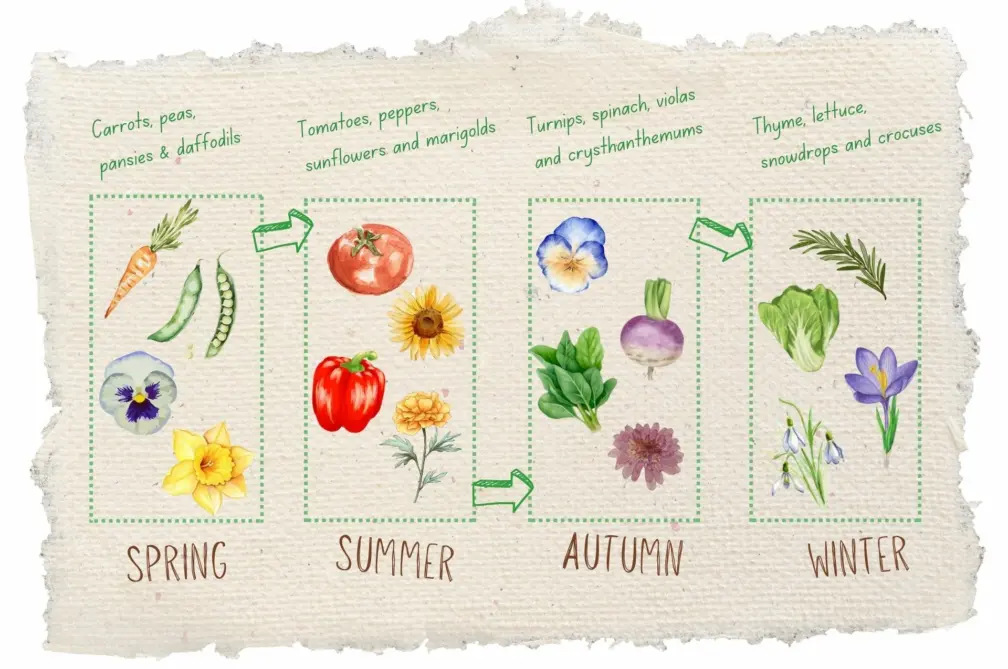
Instead, think about planting a variety of seasonal plants to give you a thriving, vibrant garden year-round.
You can test the growing conditions of your ground in different areas of your garden and note where the sunlight and shade patterns are. You can also group plants with similar growth needs together, which both looks great and helps them thrive.
.: Garden Edging
Lawn or garden edging is an easy maintenance task that turns your garden into an organised, sectioned space with minimal effort.
While similar, there's a slight difference between lawn and garden edging:
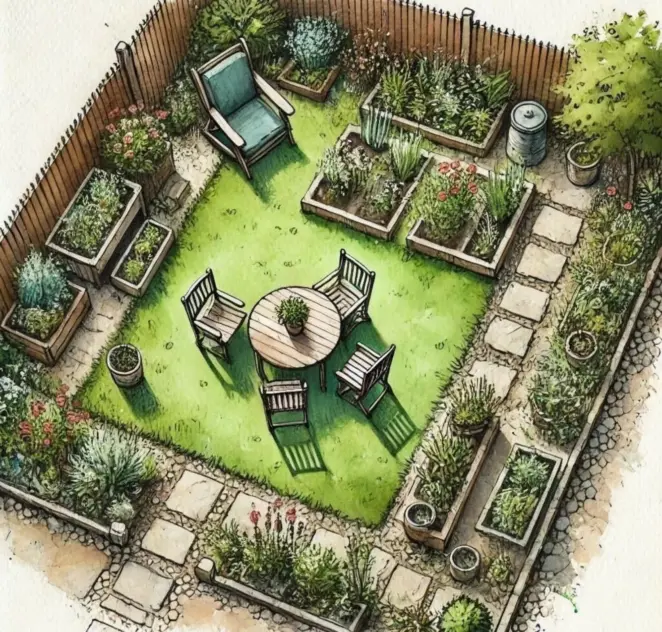
- Garden edging creates borders between different garden areas like flower beds, pathways or vegetable patches.
It is normally done using a barrier material like stone, wood or brick and is a decorative addition that separates and defines different sections in your garden.
- Lawn edging focuses specifically on your grass and defines / separates the outline of your lawn and adjoining garden areas.
It makes sure that the lawn doesn’t grow into surrounding areas and look untidy.
It is a subtle maintenance task that both controls your lawn growth and makes your small garden look neat and well-maintained.
You can use a purpose-built edging tool or a spade/half-moon edger for both lawn and garden edging. First, decide if you want straight or curved edges and mark out these areas with string or a garden hose. Then, push the tool down into the ground around 2-3 inches deep. Overlapping the cuts will make a clean, continuous, edge.
Adding material like stone / brick paving or wooden edging strips will help provide additional dimension and define different sections in your garden.
Lawn edging is an easy way to make your garden look neat, organized and also helps your plants grow separately without competing for nutrients.

.: Garden Levels
When ground space is limited, different levels are a small garden’s best friend.
One easy and quick way to utilise your garden levels is by using hanging planters to allow your plants to hang above, rather than taking up valuable ground space.You can even make your own by upcycling tin cans, old jars or plant pots for a charming, rustic look.


Raised beds or planters are another good way to add height and dimension to your small garden. They can be used for designated flower, vegetable or herb sections. You can buy these pre-built for easy installation or you can try your hand at a budget-friendly DIY option by making your own.
You can also install a trellis or a pergola to add some height to your garden where climbing plants like ivy or roses can grow upwards, encouraging them to take up vertical garden space and leaving more space on the ground for you to enjoy.
You can re-use delivery pallets as homemade trellis by sanding, painting and securing it to a wall with nails.
.: Turf
The question that’s on everybody’s minds when it comes to designing their garden is - do I buy real or artificial turf?
As a company who sells natural grass, we may be slightly biased but we believe that real grass is the best choice for a natural and vibrant outdoor space.
Real grass can add dimension and texture to your small garden and is a great choice for any pets or children who may be using the lawn as, in hotter temperatures, the grass remains cool and useable.

Some people think real grass is more work than artificial turf, but keeping a small lawn healthy is easier than you might think.
Mowing and watering are the main tasks and, if you tailor your lawn care to your garden, you'll get great results with minimal effort.
Real grass is also more durable and can naturally repair itself and withstand general wear and tear, whereas artificial turf may incur maintenance costs as the quality degrades over the years.
In worst cases, you may find yourself having to replace your artificial turf altogether.


Real grass also, simply, looks better.
Its natural feel and fine blades make any garden more aesthetically-pleasing and you'll see it change with the seasons, adding to its natural charm.
It also provides a home for local wildlife, bringing your natural garden to life.
There's so many choices of natural grass, too. Especially for a small garden, you can choose a grass type that's suitable for your needs, like one that tolerates shade or heavy foot traffic.
Our premium Rye Gold turf is recommended for smaller areas as the high percentage of rye grass in the seed mix creates a durable, fine-bladed lawn that thrives in the cool British climate.

.: Garden Furniture
Don't forget the furniture when designing your small garden - it can be the final touch to make your outdoor space feel cosy, inviting, and complete.
Compact furniture is a smart, space-saving choice for a small garden. Foldable bistro sets or smaller 2 seater garden benches are perfect for adding a rustic, stylish look and they're easy to store and rearrange.
If you’re looking for something a bit more dramatic, a hammock or hanging chair creates a unique focal point while also freeing up ground space.
With your furniture in place, you can add some finishing touches to your small garden. Decorative accessories like outdoor rugs, cushions and small fire pits / chimeneas can amplify that cosy, ‘outdoor living room’ feel.


You can install decking tiles or even make a small, raised deck to define your garden furniture area.
You can opt for easy assemble decking kits or simply install decking tiles for the same look without the hassle of construction.
Creating a dedicated furniture area maximises the appearance of space and makes it look intentional and stylish, bringing your garden to a whole new level.
.: Dimension and Depth
Adding dimension and depth to your small garden can make it look less overcrowded and intentional.
One way to do this is by dividing your garden into distinct zones for different purposes, like a seating area, vegetable / flower beds and lawn. This makes your garden look organised and intentional, rather than crowded and messy.
Instead of sharp, straight edging which can make your garden look small and rigid, use curved edging to help these different areas flow together naturally.
Adding paths or paving stones helps break up the lawn and adds visual interest to your small garden. They provide a rustic, traditional look and elongate a small lawn.
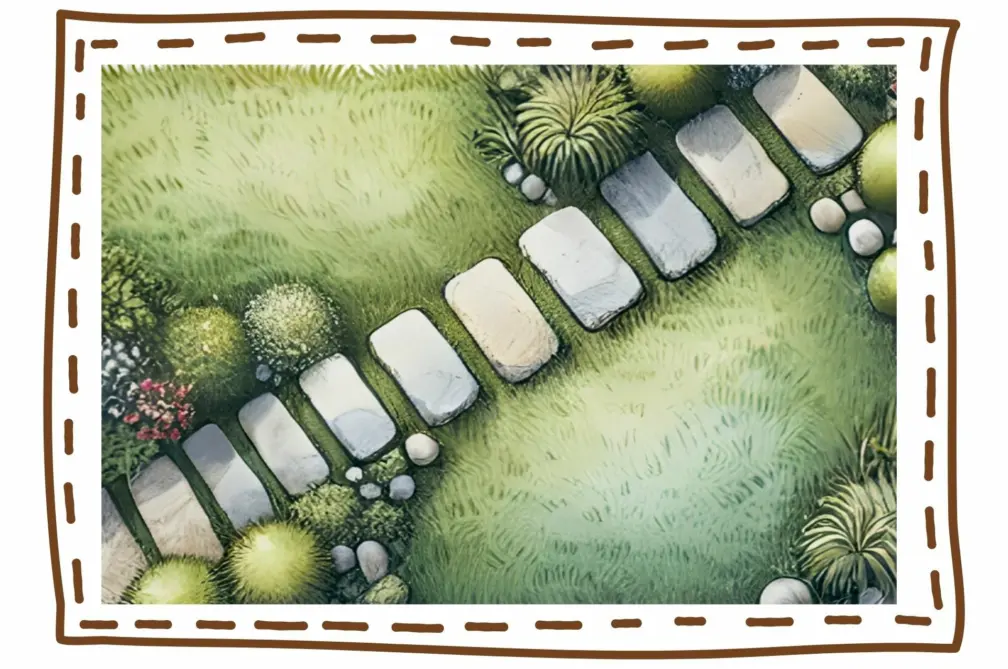
When choosing plants for your small garden, you should plant with depth in mind. Place taller plants towards the back of the garden to make the area seem dense and deep. Mixing different plant textures, colours, heights and styles will make your small garden look natural and wild.
Mirrors are a clever way to make your small garden seem larger and direct attention to specific garden elements.
.: Outdoor Lighting
Adding outdoor lighting increases ambience and creates depth, especially in the evening.
Outdoor lighting can come in many forms- you can of course get wall-mounted waterproof lamps that look expensive and stylish, but it doesn’t have to be break the bank if you’re looking for a budget friendly option.
Lanterns, candles or solar powered lights are great low budget options - they save money, electricity and, if you opt for citronella candles, they’re known to repel mosquitoes.
Some people even wrap solar powered fairy lights around trees, fences or trellis to give their garden a boho, cosy vibe.
Think about the key areas you want to highlight in your garden and plan your light positioning accordingly. If you're using solar lights, make sure they get plenty of sunlight during the day so they can charge properly.

.: Water Feature
A small water feature or 'mini pond' is a stylish addition to any garden and is is surprisingly easy to install. You should place your water feature in an area of partial shade to prevent an overgrowth of algae and to provide local wildlife like frogs and birds with a spot that's out of direct sunlight.

You can create a simple "pond" using a large ceramic bowl, a metal tub, or a sturdy plastic container. It will collect rainwater over time, and you can add wildlife-attracting elements like lily pads, algae or floating plants to elevate its look even further.
For a more integrated look (if you have the space) you can dig a hole, place your container inside, and line the edges with gravel or rocks.
The benefit of this idea is that it’s so interchangeable for different sized gardens and can be tailored to your space easily.
A water feature will naturally attract wildlife and create a little oasis, even in your small garden. It's a perfect choice for those who prefer a natural, wild garden.

.: Large Shrubbery
Trees might not be the first thing you think of when it comes to small garden ideas, but they can be a great addition to any garden.
There are different sized trees for different sized gardens. Japanese maple and Olive trees range from 10-15ft and are manageable, small options for limited space. Depending on the size, they can be also used as privacy screens to help shade your garden and make it more intimate.
To expand your options, look for trees grafted onto dwarf rootstock. This limits their size and growth rate, allowing them to stay small while still flowering or fruiting. Look for trees labelled as "dwarf varieties" or fruit trees grafted onto specific rootstock.
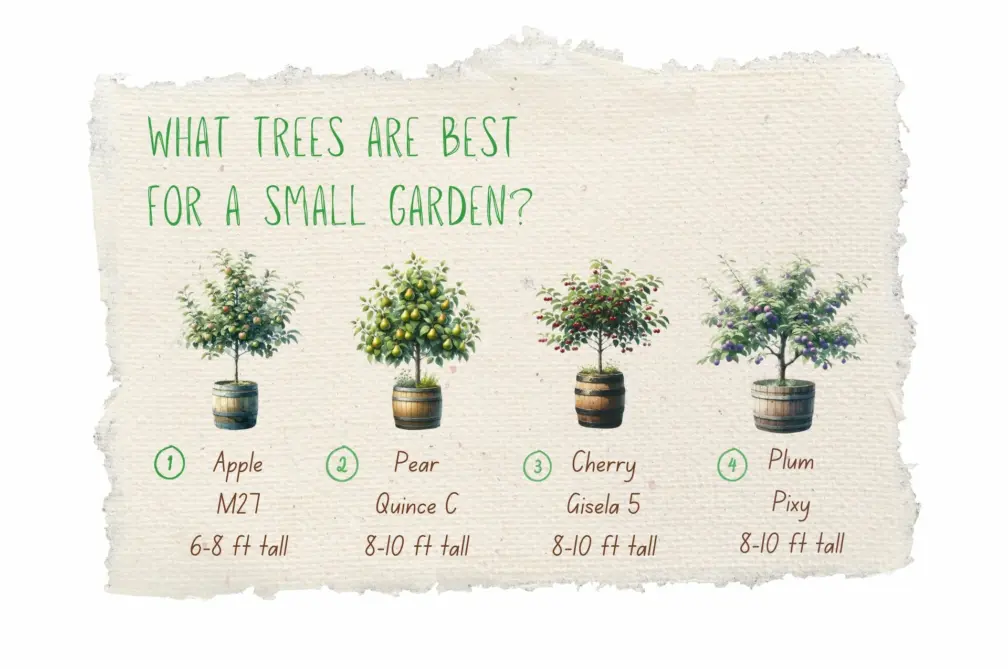
You may think that planting small plants will make a small garden seem larger, but this can actually make the space feel cramped. Using a range of plant sizes and adding focal points like trees will create dimension and variety. You should aim for a light but layered look- large but not dense shrubs are great options for smaller gardens.
.: Creative Planters
Want to add a personal and colourful touch to your small garden? There’s plenty of ways to get creative with your planting and design ideas.
You can re-purpose old ladders into tiered plant stands, or use teacups, jars, or cans as unique planters. There's countless DIY planting ideas, especially ones which utilise a slimline display or encourage vertical growth so that you can take advantage of more ground space.
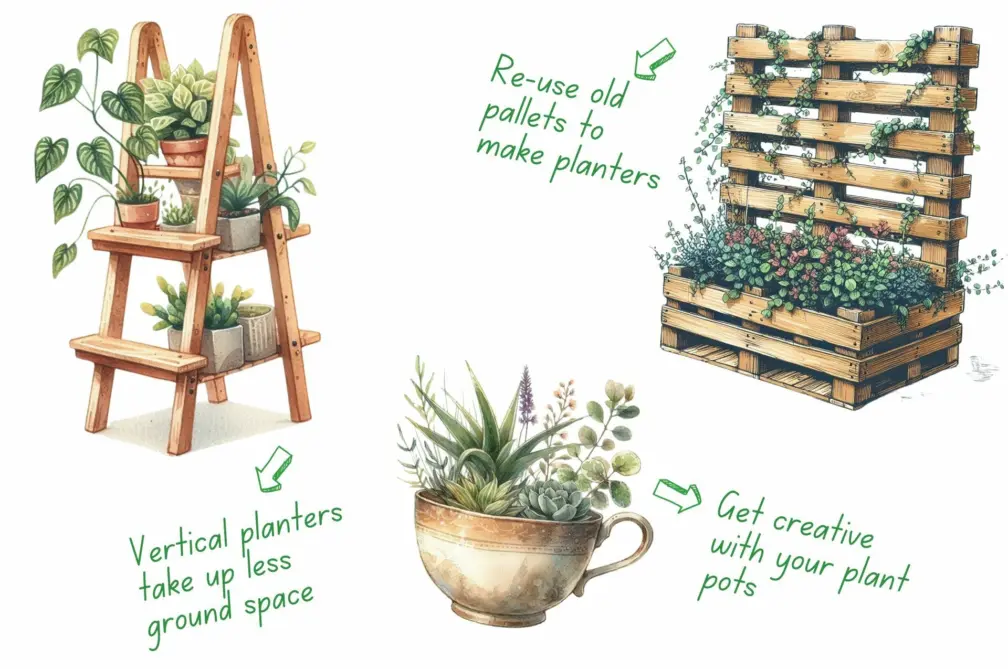
Most of these ideas are also eco-friendly, meaning that your garden can both look great and be good for the environment.
You can get creative with your plant pots too - different sizes, colours and styles can brighten up your garden and add a unique style. Painting the plant pots yourself can be a fun, personalised addition to your garden and the pops of colour will add some contrast to the greenery.
Bonus Seasonal Tip: Autumn Small Garden Tips
In Autumn, you’ll want to make sure you’re staying on top of your small garden maintenance. As your garden recovers from a busy summer, Autumn is the perfect time to prepare it for the cold winter months ahead.
As you’ll have been using your garden more over summer, you may find that your lawn has compacted from all the heavy foot traffic. Compacted soil can cause drainage issues later down the line when the heavy rainfall of Autumn comes along, so it’s best to aerate your lawn when temperatures are still mild and the soil is still malleable.
If you have a small garden, then aerating with a garden fork might be all you need to do to help improve the drainage, rather than investing in an aerating machine.
Aerating helps increase the airflow to the soil and allows water to reach the lawn roots easily. It minimises the chance of overwatering and waterlogging your garden, which is especially crucial for smaller areas.
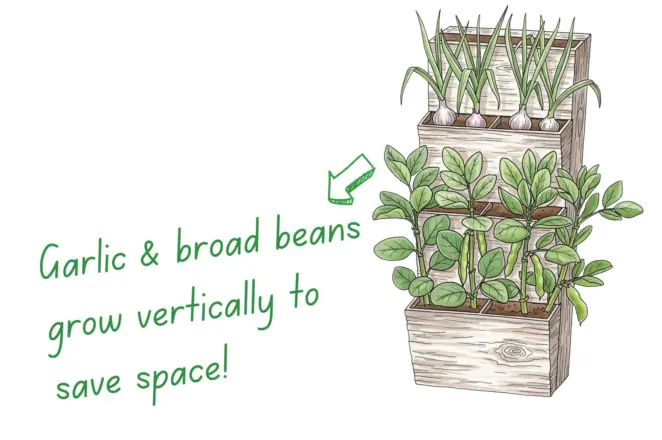
Autumn is also an excellent time for planting as the mild temperatures and humid climate are perfect for new growth.
In terms of vertical planters, broad beans or garlic are great choices as they grow upwards, taking up less ground space in your small garden.
If you plant them in Autumn, it gives them time to germinate and develop strong root systems right before winter dormancy, so that it’s settled and ready to begin growing again in Spring / Summer the following year.
By following these autumn gardening tips, your small garden will be well-prepared to survive the winter and thrive when Spring returns.
Preparation and planning is key when it comes to designing a small garden.
By organising the layout in advance, creating distinct sections and branching out with creative and simple garden design ideas, you can achieve a tidy, well-organized space that rivals even the largest gardens.
If this guide has inspired you, we'd love to see the results! Email your small garden images to photos@onlineturf.co.uk and we will feature them here.


